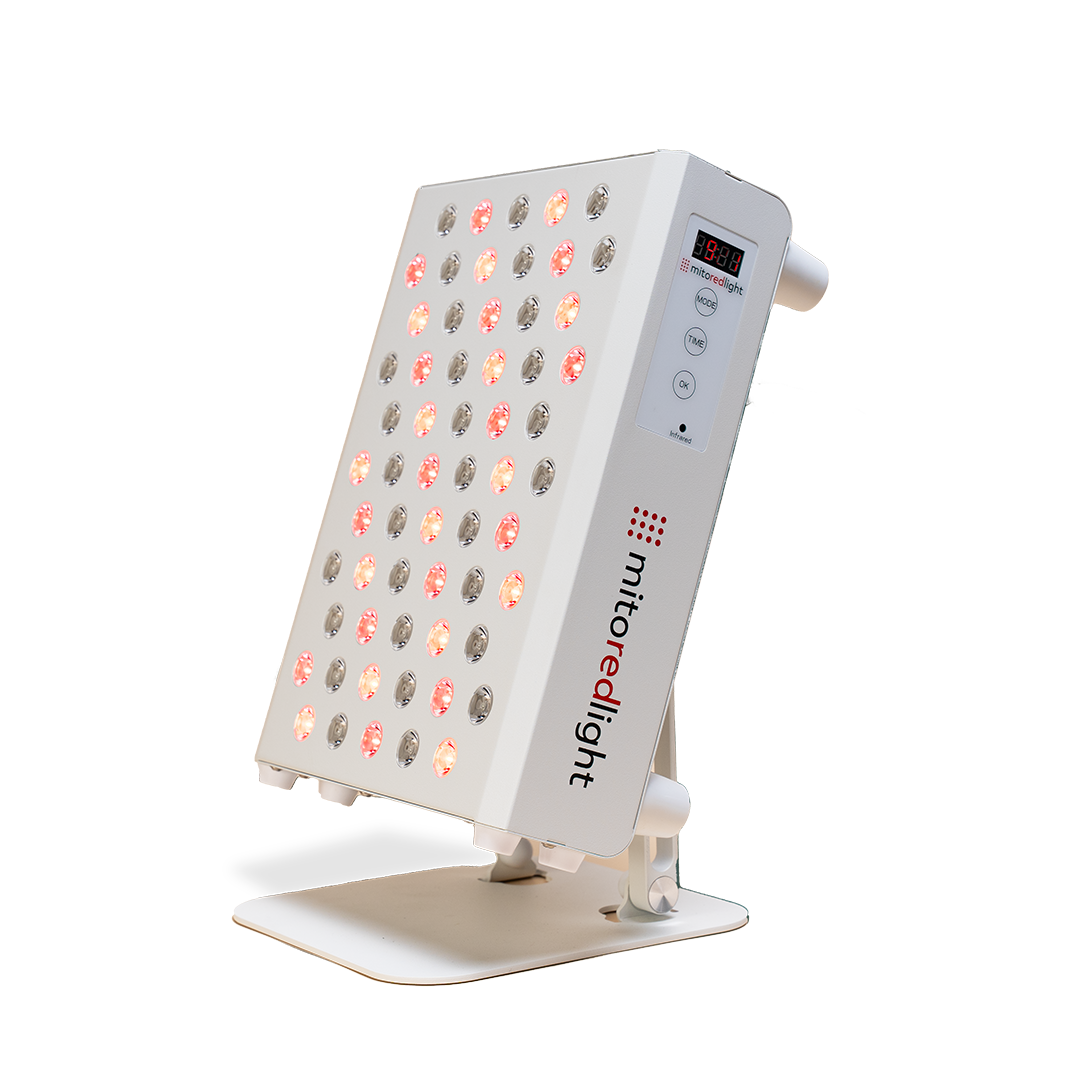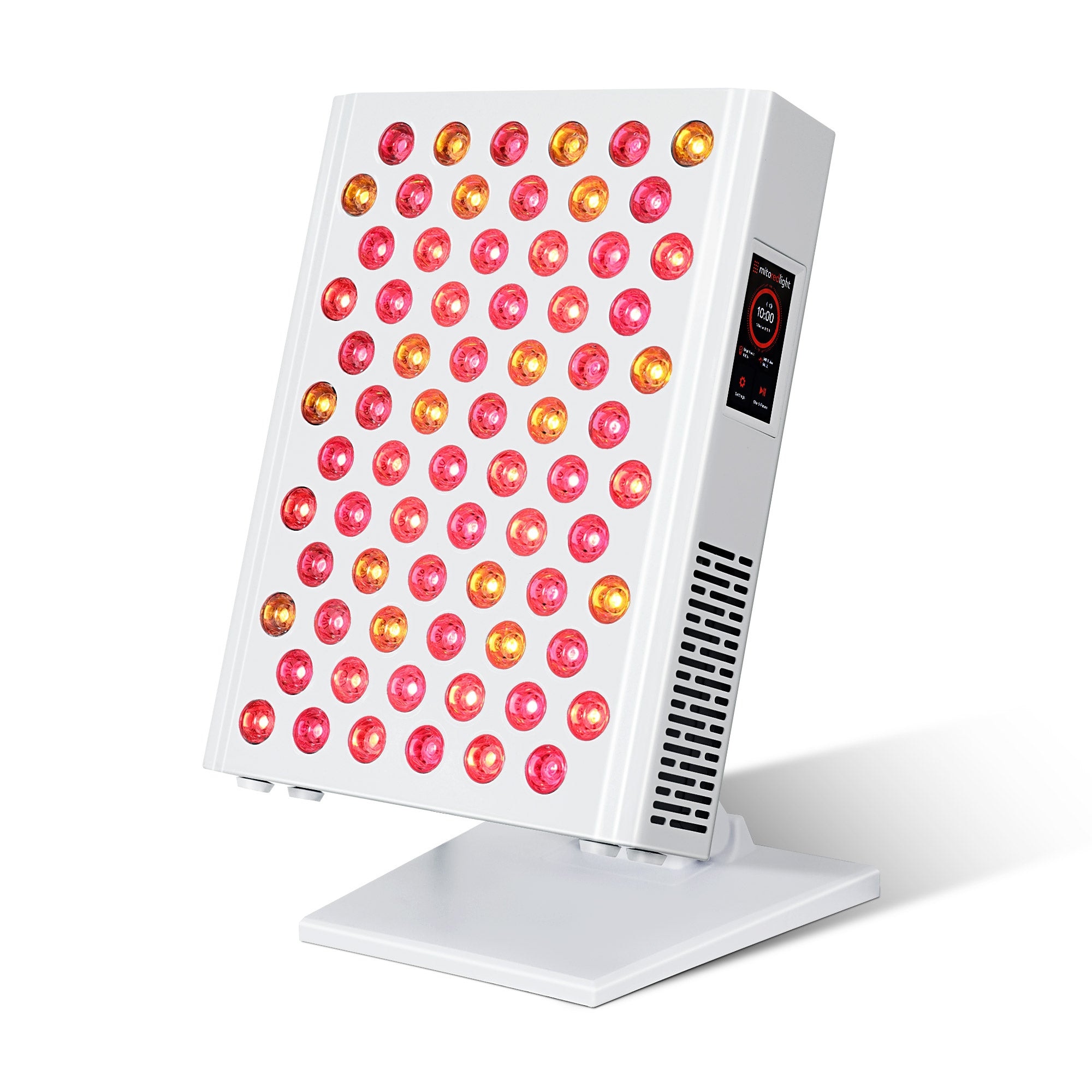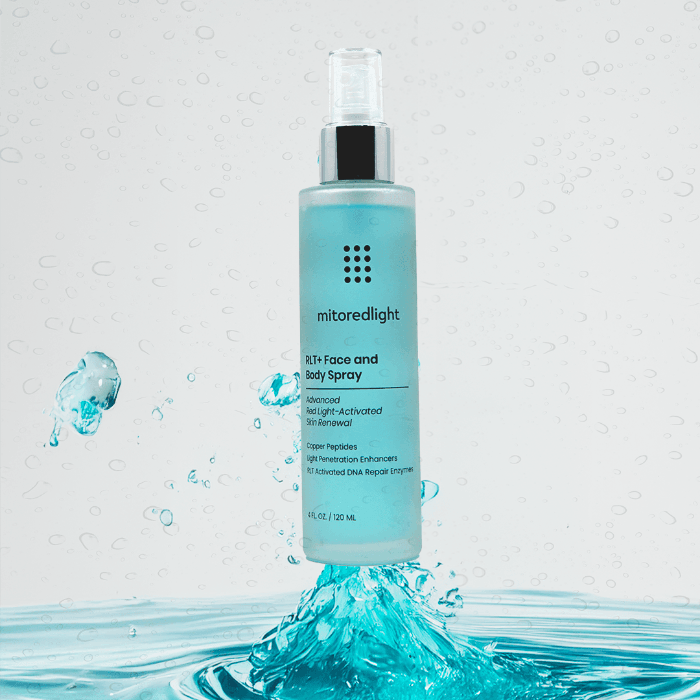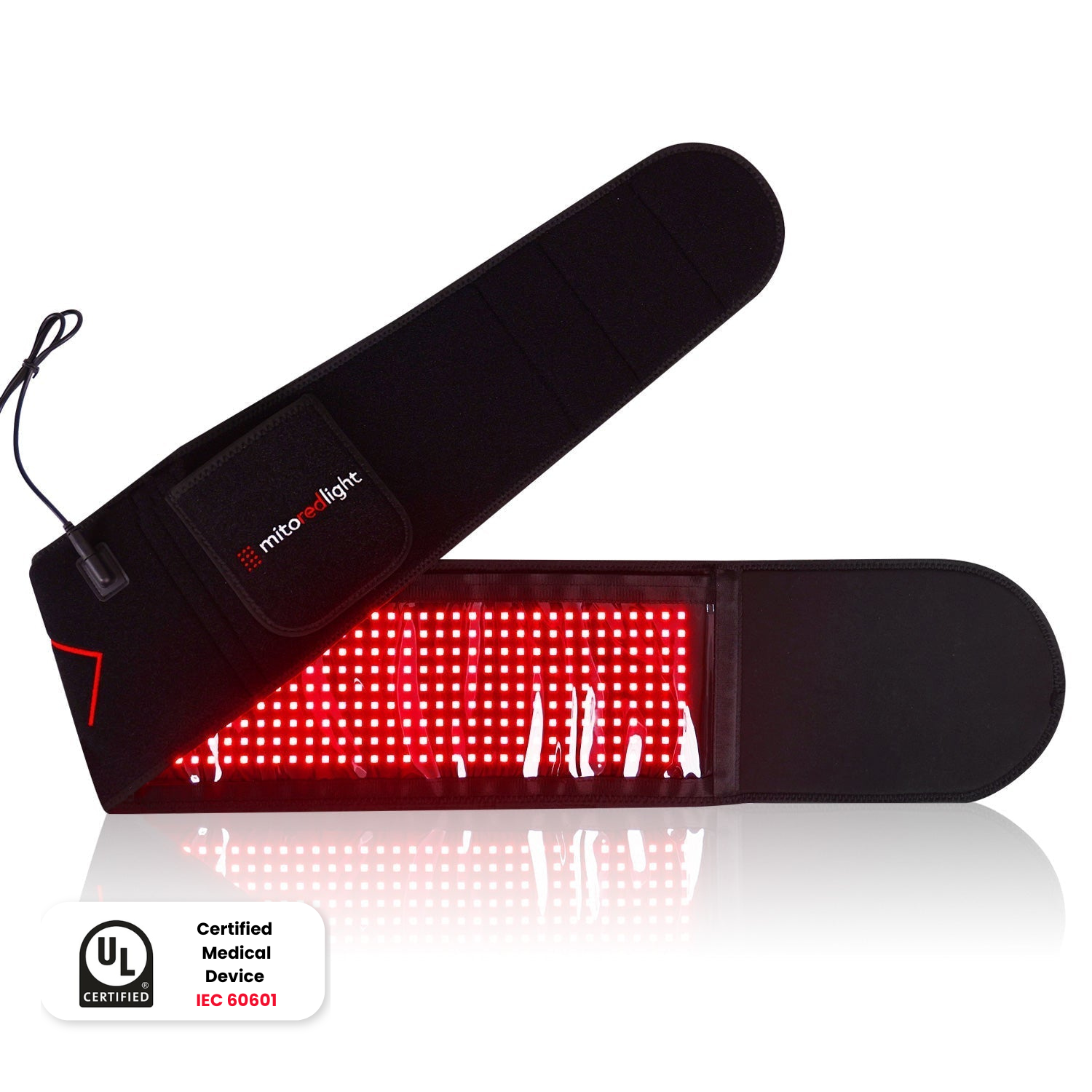DISCLAIMER: Mito Red Light devices are Class II wellness devices aimed at affecting the body through topical heating and supporting cellular function. The information provided in this article and on this site is for educational purposes only and is not intended to imply effectiveness of Mito Red Light devices for any specific application. The information provided in this article and on this site is not intended to diagnose, treat, cure, or prevent any disease, is not a substitute for consultation with a licensed medical provider and should not be construed as medical advice. Click here to read our article on potential contraindications of red light therapy..
What Red Light Therapy Wavelengths Work Best?
Summary:
Red light therapy, gaining popularity for its health benefits, utilizes specific red and near-infrared (NIR) light wavelengths to stimulate mitochondria, enhancing cellular energy (ATP) and leading to improved healing, reduced inflammation, and pain relief. Light's energy and absorption are wavelength-dependent; longer wavelengths have lower energy but penetrate deeper. Research on optimal wavelengths shows that cytochrome c oxidase in mitochondria best absorbs light in the red range (630-670nm) and NIR range (810-890nm), with studies indicating 670nm and 830nm as particularly effective. While some suggest specific wavelengths like 660nm and 850nm, likely due to availability and study volume, research supports the broader ranges. NIR light penetrates deeper, potentially benefiting deeper tissues like joints, while red light is absorbed more superficially, possibly better for skin issues. Combining red and NIR wavelengths is common in devices. Importantly, blue and green light may counteract red light's benefits by inhibiting cell growth.
Key Takeaways:
- Red light therapy stimulates mitochondria to improve cellular energy and promote healing.
- Optimal wavelengths for red light therapy fall within the red (630-670nm) and NIR (810-890nm) ranges.
- NIR light penetrates deeper into tissues, while red light is absorbed more superficially.
- Many red light therapy devices utilize a combination of red and NIR wavelengths.
- Blue and green light wavelengths may counteract the beneficial effects of red light therapy.
Medically Reviewed by | Heidi Wright, BSN, RN, PCCN
Table of Contents
- Light: Overview of Basic Principles
- Why Does Wavelength Matter?
- Wavelength and Energy
- Wavelength and Absorption
- Photobiomodulation
- How Does Red Light Therapy Work?
- What Wavelengths are Best for Red Light Therapy?
- Important Considerations
- Best Wavelengths for Red Light Therapy
- Broadband vs. Narrowband
- Studied Wavelengths
- Wavelength and Depth
- Non-Red or -NIR Wavelengths
- Mito Red Light
Red light therapy is a health phenomenon, becoming popular within the last two decades. Its recent ascendancy as a wellness tool is primarily due to light-emitting diode (LED) technology becoming more advanced and research into this new form of therapy gaining traction within mainstream scientific and medical communities. Red light therapy uses specific wavelengths of light irradiated onto specific areas of the body to achieve health benefits.
The benefits of red light therapy are thought to begin with the stimulation of small organs within each cell called mitochondria. Mitochondria are essential to energy production within cells, and stimulating these subcellular organs are thought to improve energy within the cells and lead to health benefits such as improved healing and decreased inflammation and pain.
Specifically, mitochondria produce cellular energy molecules called adenosine triphosphate, or ATP. Light energy emitted by red light and near-infrared light (NIR) targets a molecule directly involved with energy production, called cytochrome C oxidase.
Light: Overview of Basic Principles
Red light therapy is sometimes referred to as low-level laser therapy (LLLT), phototherapy, or photobiomodulation therapy. All of these refer to essentially the same type of light treatment.
In order to understand how red light therapy works and what the best wavelengths for red light therapy are, it is first necessary to have a basic understanding of the core principles of what light is and how it behaves. The question of what light actually is can be quite complex, but at a basic level, light is technically considered to be a form of electromagnetic radiation.
Electromagnetic radiation is a wave of energy that has both electrical and magnetic properties. Without going too far into the complexities of it, electromagnetic radiation can be thought of as rays of energy, with the energy that it contains being dependent on the wavelength.
Why Does Wavelength Matter?
The wavelength of electromagnetic radiation (light) is very important because it affects how much energy the electromagnetic radiation contains and how other things interact with it, also referred to as absorption. The energy of electromagnetic radiation influences how great an effect it will have, while its absorption influences what it will affect.
Wavelength and Energy

The energy that electromagnetic radiation contains is directly related to its wavelength. Longer wavelengths of electromagnetic radiation contain lower amounts of energy, while shorter wavelengths contain higher energy.
Long wavelengths of electromagnetic radiation are used to transmit radio signals and are quite harmless. These long wavelengths are typically invisible and do not affect use. Short wavelengths, however, can affect humans. X-rays are an example of electromagnetic radiation rays with short wavelengths. When used excessively, x-rays can lead to health problems, such as cancer. Very short wavelengths of electromagnetic radiation destroy cells and are used in radiation cancer treatments.
 MitoMIN |
 |
Wavelength and Absorption
The wavelength of electromagnetic radiation is also important because molecules and atoms only absorb specific wavelengths of light, reflecting all others. Microwaves used to heat food, for example, create electromagnetic radiation at a specific wavelength that is absorbed by water. This heats water molecules, ultimately heating anything inside the microwave that contains water. The electromagnetic radiation created by a microwave also creates an electrical current if conductive material like metal is present. This is why accidentally microwaving a fork can destroy a microwave.
The concept that specific wavelengths of light are absorbed by certain molecules is also what creates sight and color vision. Specific wavelengths of light are absorbed by cells in the back of your eye, stimulating signals that are transmitted to your brain. Different types of cells in your eye absorb different wavelengths of light, allowing you to distinguish color.
Wavelengths of electromagnetic radiation that are absorbed by cells in the eye make up what is called the visible portion of the electromagnetic radiation spectrum. Light is a term that is often reserved only for electromagnetic radiation that is a visible wavelength. Colors are simply made of light with different wavelengths.
Photobiomodulation
Photobiomodulation refers to changing biological processes through the use of electromagnetic radiation. The best-known forms of photobiomodulation are caused by ultraviolet light, which can be used to tan the skin, stimulate the production of vitamin D, and even break down a chemical called bilirubin in newborns.
The effects of photobiomodulation are very dependent on the wavelengths of light that are interacting with the body. Green light, for example, will not give you a tan, no matter how much you use. This is because melanocytes, the cells responsible for producing extra skin pigmentation, only absorb specific wavelengths of ultraviolet light.
How Does Red Light Therapy Work?

Red light therapy is a form of photobiomodulation that uses red and near-infrared wavelengths of light. Light consisting of these wavelengths has distinct properties that are thought to create specific health benefits.
The idea of light therapy, in general, was first conceptualized and used clinically by Niels Ryberg Finsen, a Danish physician. Finsen was awarded one of the first Nobel Prizes in Medicine for his work. It was not until NASA-led research in the mid-1990s showed health benefits from red light that the medical community began to perform research into the specifics of how red light worked.
Research into red light therapy has shown that wavelengths that are red or near-infrared are likely absorbed by a protein called cytochrome c oxidase. Cytochrome c oxidase is found in mitochondria in the cell and is an essential component of energy production within the mitochondria, specifically, and the cell in general.
What Wavelengths are Best for Red Light Therapy?
The wavelength of light used in any kind of light therapy is very important because it affects how light will be absorbed. For red light therapy, which targets cytochrome c oxidase specifically, the wavelengths that are best absorbed by this molecule will likely be the most helpful.
Important Considerations
There are two important considerations when thinking about what the best wavelengths of light for red light therapy are. One is that just because the light is absorbed by a molecule, like cytochrome c oxidase, doesn’t necessarily mean that it increases its activity. Some wavelengths of light could inhibit the activity of molecules like cytochrome c oxidase or even destroy the molecule. This being said, there are no known wavelengths of light that destroy or inhibit cytochrome c oxidase.
The other important consideration is chromatism, or how many wavelengths a light source contains. Your average light bulb contains many, many different wavelengths of light that all combine to make a white or slightly orange coloration. LED light sources, conversely, provide very specific wavelengths. Monochromatic refers to light that consists solely of a single wavelength (mono = single, chromatic = color)
While LED light sources can be quite wavelength-specific, even these sources are not purely monochromatic and will create variances in the wavelengths they produce. While a red light source may be referred to by a single wavelength, such as 660nm (nanometers), they typically include several nanometers in variation to either side of this value.
Best Wavelengths for Red Light Therapy
There has been extensive research on red light therapy using a variety of different wavelengths. Red light devices emit wavelengths from about 620nm to 750nm, while near infrared-light (NIR) is considered to be about 750nm to 1200nm. Some sources will point to 660nm and 850nm as being the “best” wavelengths for red light therapy; however, this is likely due in part to the fact that these wavelengths are more commercially available and are, in some cases, more studied than other wavelengths.
One important study published in the Journal of Biological Chemistry tested red light therapy at five different wavelengths, directly testing the chemical reaction that red light therapy is thought to cause. Researchers from the Medical College of Wisconsin and the University of Pennsylvania used a well-known poison, potassium cyanide, that is known to cause its deadly effects by inhibiting cytochrome c oxidase. Red light stimulates cytochrome c oxidase, offsetting the negative effects of cyanide. This allows the effectiveness of red light therapy on cytochrome c oxidase to be directly measured.
Researchers tested red light at 670nm, 728nm, 770nm, 830nm, and 880nm. The most effective wavelengths were shown to be 670nm and 830nm, while the least effective was shown to be 728nm. These findings are important for several reasons. Firstly, they are consistent with other research that shows two different ranges of wavelengths in which red light therapy works, one being around 630- 670nm and the other being 810-890nm. This study also used an innovative way to test if red light therapy influenced cytochrome c oxidase directly, showing that this appeared to be the case. As the study authors note, the fact that two separate wavelengths were effective while wavelengths in between had no effect indicates that the positive effects were due to the wavelengths of the light and not another factor, such as heat.
Another study, published in Lasers in Medical Science, an MIT-affiliated journal, examined four different wavelengths of light, examining how the different wavelengths affected the speed of healing on abrasions of the skin of mice. The use of mice allowed researchers to better control and measure how effective different wavelengths of light were.
The researchers studied light at 635nm, 730nm, 810nm, and 980nm. The 635nm and 810nm effectively stimulated healing, while the 730nm and 980nm light did not. The researchers also noted that the 810nm condition was measurably more effective than the 635nm condition. The authors of the study noted that these findings correlated with what is expected if the light was absorbed by cytochrome c oxidase.
Broadband vs. Narrowband
Another potential question was examined by a study published in Photomedicine and Laser Surgery to see if using narrowband light was more effective than broadband light. The narrowband red light ranged from 611-650nm, while the broadband red light included 570-850nm. This study ultimately showed that there was no significant difference; however, it did rely on more subject analysis of skin healing rather than data that could be empirically measured.
The question of broadband vs. narrowband red light sources is not well studied, and more research will be needed to determine if there is an advantage to one or the other. There may be a difference, for example, if 630nm, specifically, is used vs. using a range of 610nm-650nm. While it is interesting to theorize which would be better, more studies will be necessary to determine how effective each approach would be.
Studied Wavelengths
Ultimately, there appears to be two different areas within the red/NIR light spectrum that stimulate cytochrome c oxidase. Studies have shown effective changes within the red range of 630nm to 670nm and within the near-infrared range of 810nm to 890nm.
Some studies have tried to compare how effective the red light is vs. the near-infrared light (NIR). One study examined the effectiveness of just 630nm light vs. just 890nm light, finding that 630nm light was more effective. The Journal of Biological Chemistry study using potassium cyanide, however, has shown that 830nm light was more effective than 880nm light, meaning that perhaps the NIR value of 890nm was suboptimal.
Most professional red light therapy panel manufacturers will use a combination of light from the red range of the spectrum and the NIR portion of the spectrum. This combination is also used in many studies, ultimately making it harder to optimize either value.
Wavelength and Depth
One important consideration when comparing the 630-670nm red light with 810-890nm NIR light is the depth that each light source can reach. With light in or near the visible spectrum, the shorter-wavelength, higher-energy light will penetrate more shallowly, being absorbed very quickly by the body. This means that red light can reach deep into tissues under the skin, while ultraviolet light from the sun will normally not get beyond the top layers of skin. At this wavelength, red light targets fibroblasts in the skin which are involved with both collagen production and elastin production, and help with wound healing, skin conditions like psoriasis and eczema, and even addresses fine lines and wrinkles.
The depth of penetration of light into the tissues is, however, affected by whether the light is red or NIR. The longer-wavelength, lower-energy NIR will theoretically reach deeper tissues, having a more meaningful effect than red light will.
A study conducted by researchers from the University of Western Australia and published in PLOS ONE examined this effect. This study measured how much light reached spinal cord injuries in rats using photometric equipment. The study found that an average of 6.6% of 670nm red light reached the injuries, while 11.3% of the NIR reached the same location.
This research shows that 42% more light can reach deeper areas when longer NIR wavelengths are used. Another consideration, however, is that more of the red light is absorbed by shallow tissues. While more research is needed, this would seem to suggest that red light therapy used to treat shallow tissues, like skin blemishes and superficial injuries, is more likely to benefit from shorter red light, while deeper problems, like joint pain, may benefit more from longer NIR wavelengths. “Red light therapy is theorized to reduce inflammation, a key contributor to joint pain. By potentially mitigating inflammation and reaching deep into the body’s tissues, red light therapy may help improve joint flexibility and range of motion,” notes Heidi Wright, Registered Nurse.
Non-Red or -NIR Wavelengths
While the precise wavelengths of red light that have the best effect are not fully established, one study published in the prestigious Scientific Reports showed that using blue (415 nm) or green (540 nm) light could actually counteract the effects of red light. The researchers found that while red light therapy helps to stimulate cell growth, the blue and green wavelengths actually inhibit the same process. This finding shows the importance of using red light therapy sources that are not mixed with other types of light.
Mito Red Light
All of Mito’s products (including our at home devices) use a combination of red and near-infrared wavelengths of light. We offer products that are a combination of 660nm red light and 850nm NIR light, as well as products that use two wavelengths of red light (630nm & 660nm) and two wavelengths of NIR light (830nm & 850nm). Our red light therapy devices are all FDA-cleared and third-party tested.
Our diversified selection of products is designed to provide you with maximally effective red light therapy options. We welcome you to review our selection of high-quality products or to contact one of our expert representatives at +1 866-861-6486.
Related Articles:
- What Is Red and Near Infrared (NIR) Light Therapy?
- Why Can’t I Just Use Any Red Light Source for Red Light Therapy?
- Wavelengths, Watts, and More: Common Red Light Therapy Terms Defined























